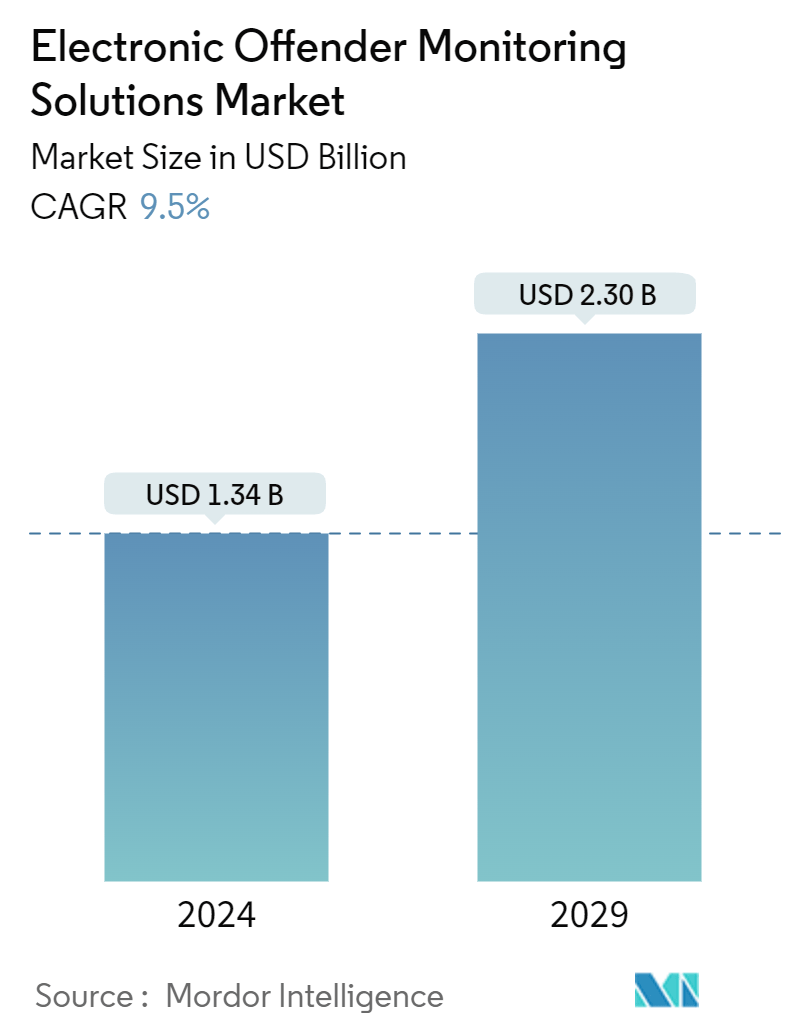Market Size of Electronic Offender Monitoring Solutions Industry

| Study Period | 2019 - 2029 |
| Market Size (2024) | USD 1.34 Billion |
| Market Size (2029) | USD 2.30 Billion |
| CAGR (2024 - 2029) | 9.50 % |
| Fastest Growing Market | Europe |
| Largest Market | North America |
Major Players
*Disclaimer: Major Players sorted in no particular order |
Electronic Offender Monitoring Solutions Market Analysis
The Electronic Offender Monitoring Solutions Market size is estimated at USD 1.34 billion in 2024, and is expected to reach USD 2.30 billion by 2029, growing at a CAGR of 9.5% during the forecast period (2024-2029).
Furthermore, the government initiatives on electronic monitoring EM programs include significant economies worldwide, which may further drive market growth in the forecast period. HMPPS, on behalf of the Home Office, has recently begun using GPS monitoring for people who have been freed from prison or immigration custody as a result of bail. The program was extended to Scotland and Northern Ireland from August 2022 until the end of 2022.
- Electronic monitoring solutions accurately and quickly locate offenders, which could be used in criminal investigations and prosecutions. Such benefits of electronic offender monitoring solutions are expected to promote the market demand for electronic monitoring solutions. Further, in May 2022, US Immigration and Customs Enforcement (ICE) announced that USD 7.2 million was spent on facial recognition and location tracking of migrants. US ICE is paying surveillance software company Trust Stamp USD 7.2 million annually to develop tech for tracking migrants processed at the southern border.
- As per the Ministry of Justice of the United Kingdom, court bail orders remain the significant cohort of individuals energetically monitored by an electronic monitoring instrument, accounting for 40 percent (5,979) of the caseload as of September 30, 2022. In response to the impact of the COVID-19 pandemic on the judiciary, electronic monitoring of those on bail increased sharply in early 2020. Although the number has fallen slightly in 2021, it is now at a record level.
- The number of people who were active in the monitoring increased between September 30, 2021, and September 30, 2022. Extensions drove this increase to the use of location (GPS) monitoring tags for new offender cohorts, particularly for immigration bail, and the continued roll-out of alcohol monitoring tags. Such an increase in the demand for electronic monitoring solutions is expected to boost the Market's growth.
- Furthermore, in September 2022, the total number of individuals actively monitored with an electronic monitoring device or alcohol monitoring device was 14,996, an increase of 12 percent compared with September 30, 2021. Although the monthly figures fluctuate, the trend over the 12 months has been upward. Such a demand trend in electronic monitoring solutions is expected to increase the demand for electronic monitoring devices in the Market during the forecast period.
- Moreover, as per the survey conducted by the Ministry of Justice, Crime Prevention Policy Bureau, on offenders on Electronic Monitoring to observe their behavior and environment and check living conditions and violation of obligations to remove factors of re-offending for their successful rehabilitation, 72 percent of the offenders has a fear of being arrested for a repeated crime, and 91.7 percentage of the offenders had self-control from doing illegal activities.
- Furthermore, the Russia-Ukraine war is impacting the supply chain of electronic components. Being a significant supplier of raw materials for producing electronic components. The dispute has disrupted the supply chain, causing shortages and price increases for these materials, impacting analytical instrument manufacturers and potentially leading to higher costs for end-users.
- The disadvantages of such facilities are their start costs, the possibility of escaping or committing crimes, community objections, and the potential loss of in-home equipment. Electronic monitoring is an additional component for some programs, and the equipment used may have technical problems that might hamper the market growth.
Electronic Offender Monitoring Solutions Industry Segmentation
Electronic monitoring is a general term directing forms of surveillance to monitor the movement, location, and specific behavior of individuals in the framework of the criminal justice process. Electronic monitoring generally uses GPS tracking methods in devices referred to as ankle bracelets, ankle shackles, or tethers to record the location of their wearers. Further, Radio Frequency and Global Positioning System technologies with solutions and services in multiple geographies segment the studied market.
The electronic offender monitoring solutions market is segmented by technology (radio frequency and global positioning system), offerings (solutions and services), and geography (North America, Europe, Asia-Pacific, Latin America, and the Middle East and Africa). The impact of macroeconomic trends on the market is also covered under the scope of the study. Further, the disturbance of the factors affecting the market's evolution in the near future has been covered in the study regarding drivers and constraints.
The market sizes and predictions are provided in terms of value in USD for all the above segments.
| By Technology | |
| Radio Frequency (RF) | |
| Global Positioning System (GPS) |
| By Offering | |
| Solutions | |
| Services |
| By Geography*** | |
| North America | |
| Europe | |
| Asia | |
| Australia and New Zealand | |
| Latin America | |
| Middle East and Africa |
Electronic Offender Monitoring Solutions Market Size Summary
The electronic offender monitoring solutions market is poised for significant growth, driven by increasing government initiatives and technological advancements. The market is expected to expand substantially over the forecast period, with various countries implementing electronic monitoring programs to enhance public safety and streamline criminal justice processes. These solutions, which include GPS tracking and alcohol monitoring devices, are being adopted to monitor offenders more effectively, reduce recidivism, and support rehabilitation efforts. The demand for these technologies is further bolstered by their application in immigration control and the management of high-risk offenders, as seen in recent programs in the United Kingdom and Canada. Despite challenges such as supply chain disruptions and community concerns, the market is experiencing a surge in adoption, particularly in Europe, where electronic monitoring is becoming increasingly prevalent.
The market landscape is characterized by intense competition, with numerous players offering cost-competitive products to capture market share. Collaborations and strategic partnerships are common, as companies seek to enhance their technological offerings and expand their geographical reach. Notable developments include the formation of Allied Universal Electronic Monitoring Services and collaborations between SCRAM Systems and Upstream, highlighting the industry's focus on innovation and integration of advanced monitoring technologies. Government investments and pilot programs, such as those in the United Kingdom and Saskatchewan, are expected to further drive market growth, as they demonstrate the effectiveness of electronic monitoring in reducing reoffending and supporting offender reintegration. As the market continues to evolve, it is likely to see increased adoption of sophisticated monitoring solutions, supported by ongoing technological advancements and favorable regulatory frameworks.
Electronic Offender Monitoring Solutions Market Size - Table of Contents
-
1. MARKET INSIGHTS
-
1.1 Market Overview
-
1.2 Industry Attractiveness - Porter's Five Forces Analysis
-
1.2.1 Bargaining Power of Suppliers
-
1.2.2 Bargaining Power of Buyers
-
1.2.3 Threat of New Entrants
-
1.2.4 Threat of Substitute Products
-
1.2.5 Intensity of Competitive Rivalry
-
-
1.3 Assessment of the Impact of Macroeconomic Trends on the Market
-
-
2. MARKET SEGMENTATION
-
2.1 By Technology
-
2.1.1 Radio Frequency (RF)
-
2.1.2 Global Positioning System (GPS)
-
-
2.2 By Offering
-
2.2.1 Solutions
-
2.2.2 Services
-
-
2.3 By Geography***
-
2.3.1 North America
-
2.3.2 Europe
-
2.3.3 Asia
-
2.3.4 Australia and New Zealand
-
2.3.5 Latin America
-
2.3.6 Middle East and Africa
-
-
Electronic Offender Monitoring Solutions Market Size FAQs
How big is the Electronic Offender Monitoring Solutions Market?
The Electronic Offender Monitoring Solutions Market size is expected to reach USD 1.34 billion in 2024 and grow at a CAGR of 9.5% to reach USD 2.30 billion by 2029.
What is the current Electronic Offender Monitoring Solutions Market size?
In 2024, the Electronic Offender Monitoring Solutions Market size is expected to reach USD 1.34 billion.

